Global General Surgery Devices Market, By Product Type, By Indication, By End User, By Region & Segmental Insights Trends and Forecast, 2024 – 2034
- Industry: Healthcare
- Report ID: TNR-110-1204
- Number of Pages: 420
- Table/Charts : Yes
- July, 2024
- Base Year : 2024
- No. of Companies : 10+
- No. of Countries : 29
- Views : 10113
- Covid Impact Covered: Yes
- War Impact Covered: Yes
- Formats : PDF, Excel, PPT
General surgery devices encompass a broad range of instruments and equipment used in surgical procedures across various medical specialties. The global market for general surgery devices is characterized by robust growth driven primarily by technological advancements, increasing surgical procedures worldwide, and the rising prevalence of chronic diseases necessitating surgical intervention. Key growth drivers include the expanding geriatric population, which requires more surgical treatments, and the growing demand for minimally invasive surgeries that reduce recovery times and hospital stays.
Current trends in the market include the adoption of robotic-assisted surgeries, which enhance precision and enable complex procedures with minimal invasiveness. Additionally, there is a notable shift towards disposable surgical instruments to reduce the risk of infections and improve operational efficiency in healthcare settings. Opportunities in the market lie in emerging economies where healthcare infrastructure is rapidly developing, coupled with increasing healthcare expenditure. Overall, the general surgery devices market is poised for significant expansion, driven by technological innovation, demographic shifts, and the continual evolution of healthcare delivery models globally. In Terms of Revenue, the Global General Surgery Devices Market was Worth US$ 16.5 Bn in 2023, Anticipated to Witness CAGR of 9.1% During 2024 – 2034.
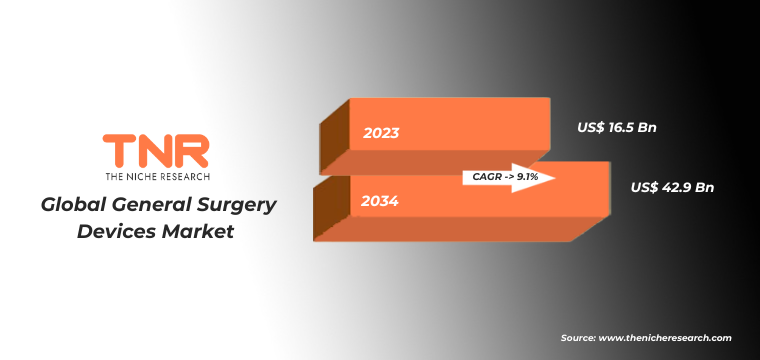
Growth Drivers of Global General Surgery Devices Market
- Increasing Surgical Procedures: The rising incidence of chronic diseases and age-related ailments requiring surgical intervention is significantly boosting the demand for general surgery devices. As global healthcare access improves and populations age, there is a concurrent increase in the number of surgical procedures performed. This trend is particularly pronounced in emerging economies where healthcare infrastructure upgrades and rising disposable incomes enable more people to undergo surgeries. Advancements in medical diagnostics and screening techniques are identifying conditions earlier, leading to proactive surgical interventions. Consequently, there is a growing market for general surgery devices, including instruments, equipment, and implants, to cater to the expanding volume and complexity of surgical procedures worldwide.
- Technological Advancements: Innovations such as robotic-assisted surgery systems, advanced imaging techniques like MRI and CT scans for pre-operative planning, and the development of minimally invasive surgical tools have revolutionized surgical procedures. These advancements improve surgical precision, reduce recovery times, and enhance patient outcomes, thereby driving their adoption across healthcare facilities worldwide. For instance, in October 2022, Medtronic, a prominent player in healthcare technology globally, unveiled significant developments with its HugoTM robotic-assisted surgery (RAS) system, including global market entry and approvals for various applications. As technology continues to advance, there is a growing demand for sophisticated surgical devices that offer higher efficiency, greater safety, and improved patient comfort, fostering further market growth.
Handheld devices by product type category have emerged as a dominant segment in the global general surgery devices market due to their versatility and ease of use in surgical procedures.
These devices include surgical instruments such as scalpels, forceps, retractors, and scissors, designed to be held and operated directly by hand during surgeries. Their popularity stems from advancements in materials and design that enhance precision and maneuverability, crucial for delicate and complex procedures. Healthcare providers favor handheld devices for their ability to facilitate minimally invasive techniques, reducing trauma to patients and accelerating recovery times.
Moreover, the compact nature of handheld devices allows for greater flexibility within surgical settings, enabling surgeons to perform a wide range of procedures efficiently. As surgical practices continue to evolve towards less invasive approaches, the demand for ergonomic and efficient handheld devices is expected to grow, further consolidating their position as a leading product category in the global market.
In 2023, cardiology segment solidified its position as the second-largest indication category within the global general surgery devices market.
This growth is driven by increasing incidences of cardiovascular diseases worldwide, prompting higher demand for specialized surgical devices tailored to cardiac procedures. These devices include a wide array of tools such as cardiac stents, pacemakers, defibrillators, and angioplasty balloons, designed to diagnose, treat, and manage heart conditions effectively. Technological advancements in cardiac surgery devices have significantly improved patient outcomes by enhancing precision, reducing procedural risks, and minimizing recovery times.
Moreover, rising healthcare expenditure and improved access to advanced medical facilities in both developed and developing regions have bolstered market expansion. As cardiovascular diseases continue to pose significant health challenges globally, the cardiology segment is poised for continued growth, with ongoing innovations and investments expected to further enhance the capabilities and adoption of general surgery devices in cardiac care.
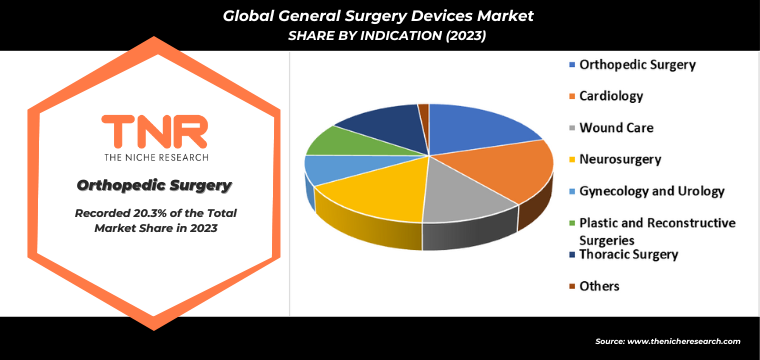
Hospitals segment by end user dominated the global general surgery devices market in 2023 with a CAGR of 7.1%.
Hospitals constitute the primary setting for surgical interventions, ranging from routine procedures to complex surgeries requiring advanced medical devices. This dominance is attributed to the increasing number of surgical procedures performed in hospital settings globally, driven by demographic shifts, technological advancements, and the prevalence of chronic diseases necessitating surgical interventions. Hospitals benefit from their extensive infrastructure, skilled medical professionals, and access to comprehensive surgical equipment, including general surgery devices such as imaging systems, surgical instruments, and patient monitoring tools.
Moreover, the trend towards minimally invasive surgeries has further propelled the demand for specialized devices that enhance surgical precision and patient outcomes within hospital environments. As healthcare systems worldwide continue to prioritize surgical advancements and patient care, the hospitals segment is expected to maintain its leading position, supported by ongoing investments in healthcare infrastructure and technological innovation.
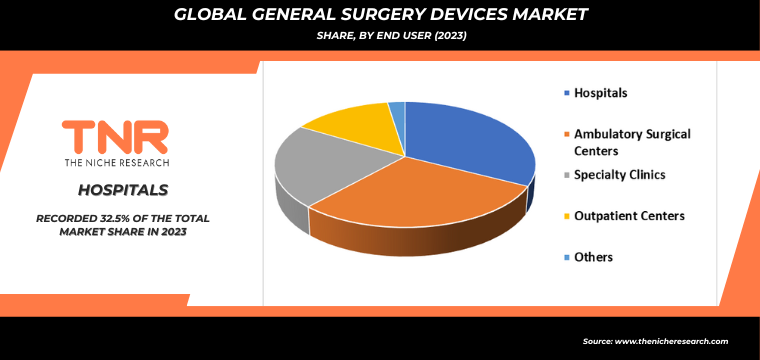
In 2023, North America solidified its dominance in the global general surgery devices market, contributing a revenue share of 32.5%.
This dominance is underpinned by several factors, including advanced healthcare infrastructure, high healthcare expenditure, and a robust regulatory framework that fosters innovation and market access for medical devices. The region’s strong position is further supported by a growing prevalence of chronic diseases necessitating surgical interventions, coupled with a significant adoption of advanced surgical technologies and devices. Additionally, the presence of major market players and research institutions dedicated to medical advancements contributes to North America’s role as a hub for medical innovation in general surgery devices.
Favorable reimbursement policies and increasing awareness about the benefits of minimally invasive surgeries have propelled market growth in the region. With ongoing investments in healthcare and continuous technological advancements, North America is expected to maintain its dominant position in the global market for general surgery devices in the foreseeable future.
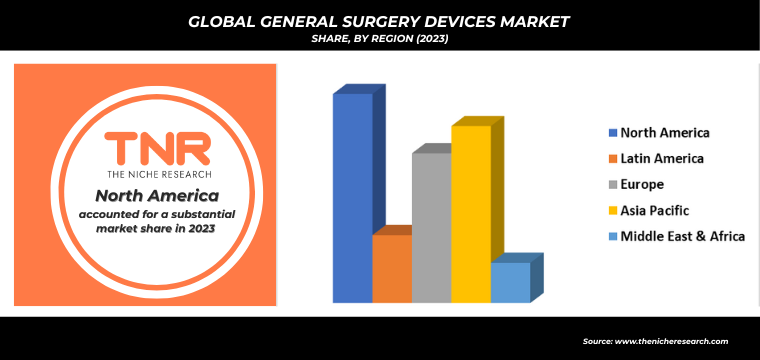
Competitive Landscape
Some of the players operating in the general surgery devices market are
- Braun Melsungen AG
- BD
- CooperSurgical, Inc.
- Hangzhou Kangji Medical Instrument Co., Ltd
- Intuitive Surgical Inc
- Janssen Pharmaceutical
- KARL STORZ GmbH & Co. KG
- Medtronic
- Olympus America Inc
- Richard Wolf GmbH
- Smith+Nephew
- Stryker Corporation
- Zhejiang Geyi Medical Instrument Co., Ltd
- Other Industry Participants
Global General Surgery Devices Market Scope
| Report Specifications | Details |
| Market Revenue in 2023 | US$ 16.5 Bn |
| Market Size Forecast by 2034 | US$ 42.9 Bn |
| Growth Rate (CAGR) | 9.1% |
| Historic Data | 2016 – 2022 |
| Base Year for Estimation | 2023 |
| Forecast Period | 2024 – 2034 |
| Report Inclusions | Market Size & Estimates, Market Dynamics, Competitive Scenario, Trends, Growth Factors, Market Determinants, Key Investment Segmentation, Product/Service/Solutions Benchmarking |
| Segments Covered | By Product Type, By Indication, By End User, By Region |
| Regions Covered | North America, Europe, Asia Pacific, Middle East & Africa, Latin America |
| Countries Covered | U.S., Canada, Mexico, Rest of North America, France, The UK, Spain, Germany, Italy, Nordic Countries (Denmark, Finland, Iceland, Sweden, Norway), Benelux Union (Belgium, The Netherlands, Luxembourg), Rest of Europe, China, Japan, India, New Zealand, Australia, South Korea, Southeast Asia (Indonesia, Thailand, Malaysia, Singapore, Rest of Southeast Asia), Rest of Asia Pacific, Saudi Arabia, UAE, Egypt, Kuwait, South Africa, Rest of Middle East & Africa, Brazil, Argentina, Rest of Latin America |
| Key Players | B. Braun Melsungen AG, BD, CooperSurgical, Inc., Hangzhou Kangji Medical Instrument Co., Ltd, Intuitive Surgical Inc, Janssen Pharmaceutical, KARL STORZ GmbH & Co. KG, Medtronic, Olympus America Inc, Richard Wolf GmbH, Smith+Nephew, Stryker Corporation, Zhejiang Geyi Medical Instrument Co., Ltd |
| Customization Scope | Customization allows for the inclusion/modification of content pertaining to geographical regions, countries, and specific market segments. |
| Pricing & Procurement Options | Explore purchase options tailored to your specific research requirements |
| Contact Details | Consult With Our Expert
Japan (Toll-Free): +81 663-386-8111 South Korea (Toll-Free): +82-808- 703-126 Saudi Arabia (Toll-Free): +966 800-850-1643 United Kingdom: +44 753-710-5080 United States: +1 302-232-5106 E-mail: askanexpert@thenicheresearch.com
|
Global General Surgery Devices Market
By Product Type
- Handheld Devices
- Scalpels
- Forceps
- Scissors
- Retractors
- Deaver Retractor
- Army-Navy Retractor
- Weitlaner Retractor
- Bookwalter Retractor
- Richardson Retractor
- Needle and Suture
- Clamps
- Others
- Electrosurgical Devices
- Minimally Invasive Surgery Devices
- Laparoscopes
- Endoscopes
- Trocars
- Insufflation Devices
- Others
- Surgical Sutures and Staplers
- Energy-based Devices
- Laser-based Devices
- Radiofrequency-based Devices
- Ultrasonic Devices
- Others
- Others
By Indication
- Orthopedic Surgery
- Cardiology
- Wound Care
- Neurosurgery
- Gynecology and Urology
- Plastic and Reconstructive Surgeries
- Thoracic Surgery
- Others
By End User
- Hospitals
- Ambulatory Surgical Centers
- Specialty Clinics
- Outpatient Centers
- Others
By Region
- North America (U.S., Canada, Mexico, Rest of North America)
- Europe (France, The UK, Spain, Germany, Italy, Nordic Countries (Denmark, Finland, Iceland, Sweden, Norway), Benelux Union (Belgium, The Netherlands, Luxembourg), Rest of Europe)
- Asia Pacific (China, Japan, India, New Zealand, Australia, South Korea, Southeast Asia (Indonesia, Thailand, Malaysia, Singapore, Rest of Southeast Asia), Rest of Asia Pacific)
- Middle East & Africa (Saudi Arabia, UAE, Egypt, Kuwait, South Africa, Rest of Middle East & Africa)
- Latin America (Brazil, Argentina, Rest of Latin America)
Report Layout:
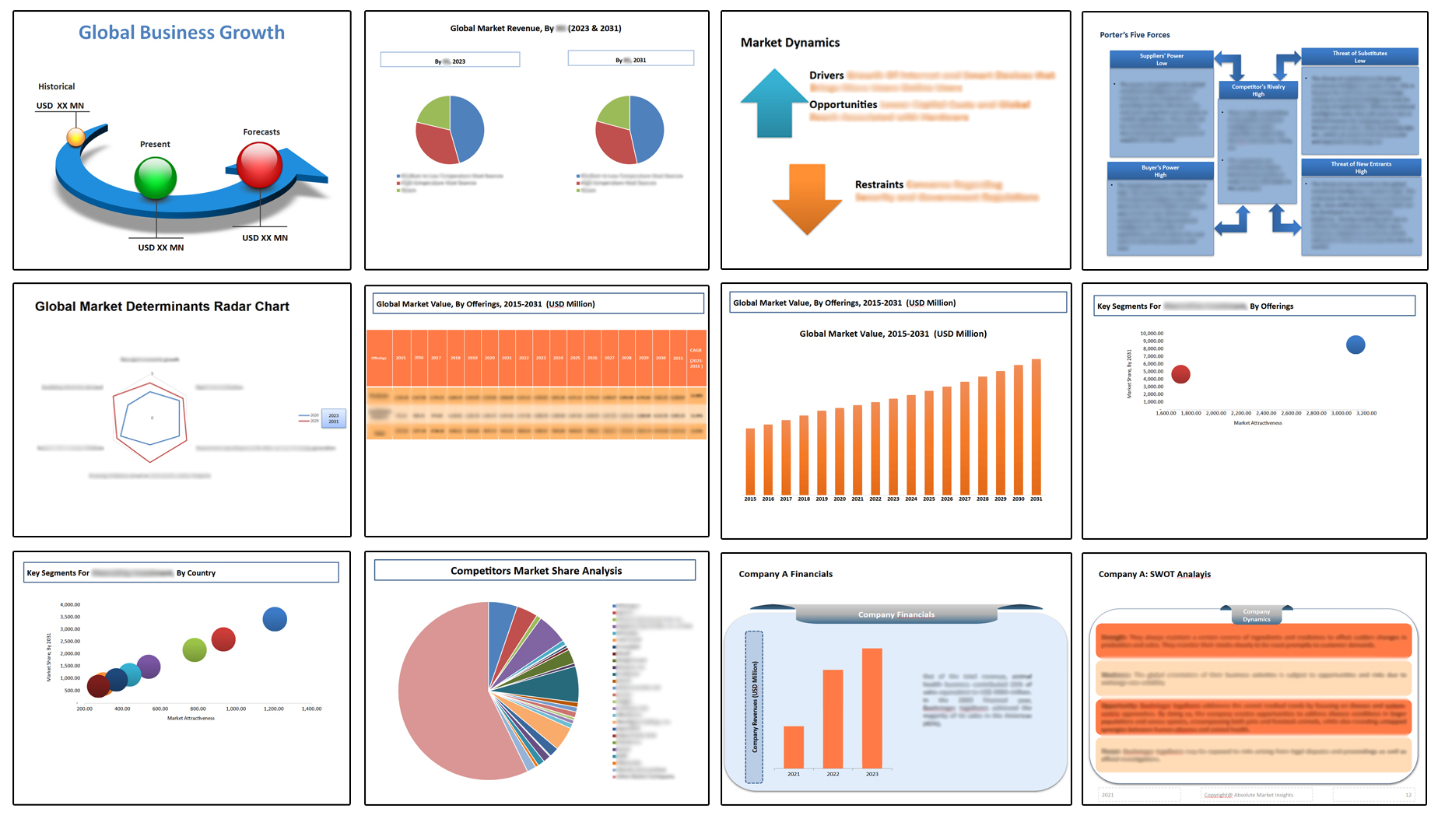
Table of Contents
Note: This ToC is tentative and can be changed according to the research study conducted during the course of report completion.
**Exclusive for Multi-User and Enterprise User.
Global General Surgery Devices Market
By Product Type
- Handheld Devices
- Scalpels
- Forceps
- Scissors
- Retractors
- Deaver Retractor
- Army-Navy Retractor
- Weitlaner Retractor
- Bookwalter Retractor
- Richardson Retractor
- Needle and Suture
- Clamps
- Others
- Electrosurgical Devices
- Minimally Invasive Surgery Devices
- Laparoscopes
- Endoscopes
- Trocars
- Insufflation Devices
- Others
- Surgical Sutures and Staplers
- Energy-based Devices
- Laser-based Devices
- Radiofrequency-based Devices
- Ultrasonic Devices
- Others
- Others
By Indication
- Orthopedic Surgery
- Cardiology
- Wound Care
- Neurosurgery
- Gynecology and Urology
- Plastic and Reconstructive Surgeries
- Thoracic Surgery
- Others
By End User
- Hospitals
- Ambulatory Surgical Centers
- Specialty Clinics
- Outpatient Centers
- Others
By Region
- North America (U.S., Canada, Mexico, Rest of North America)
- Europe (France, The UK, Spain, Germany, Italy, Nordic Countries (Denmark, Finland, Iceland, Sweden, Norway), Benelux Union (Belgium, The Netherlands, Luxembourg), Rest of Europe)
- Asia Pacific (China, Japan, India, New Zealand, Australia, South Korea, Southeast Asia (Indonesia, Thailand, Malaysia, Singapore, Rest of Southeast Asia), Rest of Asia Pacific)
- Middle East & Africa (Saudi Arabia, UAE, Egypt, Kuwait, South Africa, Rest of Middle East & Africa)
- Latin America (Brazil, Argentina, Rest of Latin America)
The Niche Research approach encompasses both primary and secondary research methods to provide comprehensive insights. While primary research is the cornerstone of our studies, we also incorporate secondary research sources such as company annual reports, premium industry databases, press releases, industry journals, and white papers.
Within our primary research, we actively engage with various industry stakeholders, conducting paid interviews and surveys. Our meticulous analysis extends to every market participant in major countries, allowing us to thoroughly examine their portfolios, calculate market shares, and segment revenues.
Our data collection primarily focuses on individual countries within our research scope, enabling us to estimate regional market sizes. Typically, we employ a bottom-up approach, meticulously tracking trends in different countries. We analyze growth drivers, constraints, technological innovations, and opportunities for each country, ultimately arriving at regional figures.Our process begins by examining the growth prospects of each country. Building upon these insights, we project growth and trends for the entire region. Finally, we utilize our proprietary model to refine estimations and forecasts.
Our data validation standards are integral to ensuring the reliability and accuracy of our research findings. Here’s a breakdown of our data validation processes and the stakeholders we engage with during our primary research:
- Supply Side Analysis: We initiate a supply side analysis by directly contacting market participants, through telephonic interviews and questionnaires containing both open-ended and close-ended questions. We gather information on their portfolios, segment revenues, developments, and growth strategies.
- Demand Side Analysis: To gain insights into adoption trends and consumer preferences, we reach out to target customers and users (non-vendors). This information forms a vital part of the qualitative analysis section of our reports, covering market dynamics, adoption trends, consumer behavior, spending patterns, and other related aspects.
- Consultant Insights: We tap into the expertise of our partner consultants from around the world to obtain their unique viewpoints and perspectives. Their insights contribute to a well-rounded understanding of the markets under investigation.
- In-House Validation: To ensure data accuracy and reliability, we conduct cross-validation of data points and information through our in-house team of consultants and utilize advanced data modeling tools for thorough verification.
The forecasts we provide are based on a comprehensive assessment of various factors, including:
- Market Trends and Past Performance (Last Five Years): We accurately analyze market trends and performance data from preceding five years to identify historical patterns and understand the market’s evolution.
- Historical Performance and Growth of Market Participants: We assess the historical performance and growth trajectories of key market participants. This analysis provides insights into the competitive landscape and individual company strategies.
- Market Determinants Impact Analysis (Next Eight Years): We conduct a rigorous analysis of the factors that are projected to influence the market over the next eight years. This includes assessing both internal and external determinants that can shape market dynamics.
- Drivers and Challenges for the Forecast Period:Identify the factors expected to drive market growth during the forecast period, as well as the challenges that the industry may face. This analysis aids in deriving an accurate growth rate projection.
- New Acquisitions, Collaborations, or Partnerships: We keep a close watch on any new acquisitions, collaborations, or partnerships within the industry. These developments can have a significant impact on market dynamics and competitiveness.
- Macro and Micro Factors Analysis:A thorough examination of both macro-level factors (e.g., economic trends, regulatory changes) and micro-level factors (e.g., technological advancements, consumer preferences) that may influence the market during the forecast period.
- End-User Sentiment Analysis: To understand the market from the end-user perspective, we conduct sentiment analysis. This involves assessing the sentiment, preferences, and feedback of the end-users, which can provide valuable insights into market trends.
- Perspective of Primary Participants: Insights gathered directly from primary research participants play a crucial role in shaping our forecasts. Their perspectives and experiences provide valuable qualitative data.
- Year-on-Year Growth Trend: We utilize a year-on-year growth trend based on historical market growth and expected future trends. This helps in formulating our growth projections, aligning them with the market’s historical performance.
Research process adopted by TNR involves multiple stages, including data collection, validation, quality checks, and presentation. It’s crucial that the data and information we provide add value to your existing market understanding and expertise. We have also established partnerships with business consulting, research, and survey organizations across regions and globally to collaborate on regional analysis and data validation, ensuring the highest level of accuracy and reliability in our reports.









